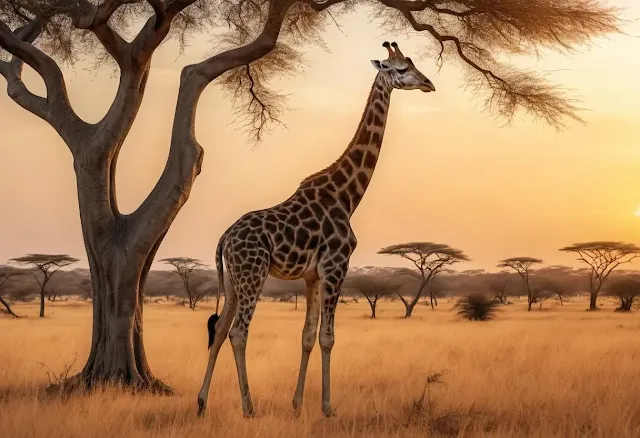Endangered Giraffes: A Race Against Extinction – How We Can Save These Gentle Giants
Picture the open plains of Africa, where the gentle swaying of acacia trees is punctuated by the graceful presence of giraffes. Their elongated necks and striking patterns are both iconic and irreplaceable. Yet, these towering giants are in peril. Over the past three decades, giraffe populations have declined by nearly 40%, earning them a place on the endangered species list.
Endangered Giraffes
This article explores why giraffes are endangered, the efforts being made to protect them, and how you can help ensure these magnificent creatures continue to thrive.
Understanding the Crisis
Why Are Giraffes Endangered?
Giraffes are not only symbols of Africa's diverse wildlife but also integral to the ecosystem. Despite their ecological importance, their populations face numerous threats:
- Habitat Loss
- Poaching and Illegal Trade
- Climate Change
Key Statistics
| Threat | Impact |
|---|---|
| Habitat Loss | Fragmentation of ecosystems, reduced food sources |
| Poaching | Decline in populations, disruption of herds |
| Climate Change | Food scarcity, increased mortality rates |
Giraffe Subspecies and Their Status
There are nine subspecies of giraffes, each with unique markings and regional habitats. Unfortunately, several are critically endangered.
| Subspecies | Population | Status |
|---|---|---|
| Nubian Giraffe | ~2,000 | Critically Endangered |
| Kordofan Giraffe | ~2,000 | Critically Endangered |
| Reticulated Giraffe | ~11,000 | Endangered |
| Masai Giraffe | ~45,000 | Vulnerable |
| Southern Giraffe | ~52,000 | Near Threatened |
The Nubian and Kordofan giraffes are especially at risk, with populations confined to small, fragmented regions.
The Role of Giraffes in the Ecosystem
Keystone Species
Giraffes are considered a keystone species, meaning their presence is crucial to the health of their ecosystems. Their browsing habits shape the environment in several ways:
- Tree Pruning: By feeding on high branches, giraffes encourage new growth and prevent trees from dominating the savannah.
- Seed Dispersal: Their movement across vast areas helps spread seeds, fostering plant diversity.
- Food Chain Support: Giraffe carcasses provide sustenance for scavengers like lions, hyenas, and vultures.
Conservation Efforts: A Global Mission
International Organizations Making a Difference
Conservation efforts have gained momentum, thanks to the collaboration of governments, NGOs, and local communities:
- Giraffe Conservation Foundation (GCF):
- CITES (Convention on International Trade in Endangered Species):
- IUCN Red List:
Community-Driven Solutions
Local communities are instrumental in conservation efforts. Programs such as sustainable farming, eco-tourism, and wildlife-friendly agriculture provide economic incentives while protecting giraffe habitats.
Success Stories
One of the most inspiring stories comes from Niger, where the population of West African giraffes has increased from 49 in the 1990s to over 600 today. This success is attributed to strict anti-poaching laws and community-led conservation initiatives.
Challenges in Conservation
Despite progress, challenges persist:
- Funding Gaps: Conservation programs require substantial resources, which are often limited.
- Human-Wildlife Conflict: As human settlements expand, giraffes increasingly compete with livestock for food and water.
- Political Instability: In regions affected by conflict, enforcing wildlife protections becomes difficult.
How You Can Help Save Giraffes
Donate or Volunteer
Supporting organizations like the Giraffe Conservation Foundation or the Wildlife Conservation Society can have a significant impact. Donations fund anti-poaching patrols, research, and habitat restoration.
Raise Awareness
Social media is a powerful tool for spreading awareness. Sharing facts, stories, and conservation updates can inspire others to take action.
Advocate for Policy Change
Write to policymakers and support legislation aimed at wildlife conservation. Advocacy can lead to stronger protections for giraffes and other endangered species.
Eco-Friendly Practices
Even small lifestyle changes, like reducing plastic use or supporting sustainable products, contribute to a healthier planet for all species.
Educational Initiatives
Teaching the Next Generation
Educating children about the importance of giraffes and wildlife conservation fosters a sense of responsibility. Programs in schools and zoos can inspire future conservationists.
Public Campaigns
Organizations often launch campaigns to engage the public. Participating in events like World Giraffe Day raises funds and awareness for giraffe conservation.
The Role of Technology in Conservation
GPS Tracking
Modern technology allows researchers to track giraffe movements using GPS collars. This data helps identify migration patterns and threats.
Drones and Camera Traps
Drones and camera traps monitor giraffes in remote areas, providing valuable insights without disturbing their natural behaviors.
Data Sharing
Platforms like the IUCN’s online database allow conservationists to share findings, fostering global collaboration.
Frequently Asked Questions (FAQs)
Q: Why are giraffes endangered?
A: Giraffes face threats from habitat loss, poaching, and climate change. Their populations have declined by nearly 40% in the past 30 years.Q: What is the current population of giraffes?
A: Approximately 117,000 giraffes remain in the wild, with some subspecies critically endangered.Q: How can I help save giraffes?
A: You can support conservation organizations, raise awareness, and advocate for wildlife-friendly policies.Q: Are giraffes protected under international law?
A: Yes, giraffes are listed under CITES, which regulates the trade of giraffe products to protect the species.Conclusion
The plight of endangered giraffes serves as a stark reminder of the fragility of our natural world. While their numbers continue to dwindle, hope is not lost. Conservation efforts—ranging from local initiatives to international collaborations—are making a difference.
Endangered Giraffes
You, too, can contribute to the cause. Whether by donating, raising awareness, or advocating for change, every action matters. Together, we can ensure that future generations will marvel at giraffes in the wild, not just in history books.
Now is the time to act. Let’s save these gentle giants from extinction and preserve their place in our world’s vibrant tapestry of life.

